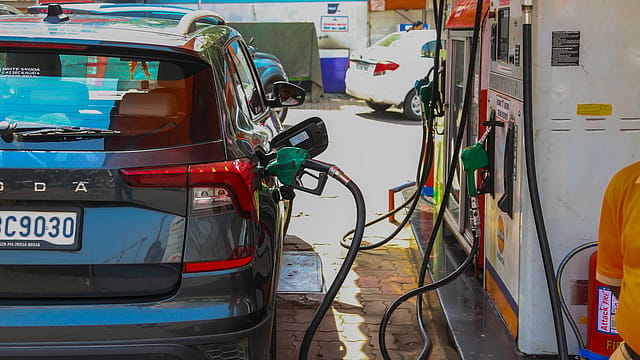India's net zero challenge: PVs to grow 4.6 times, cargo vehicles 6.5 times by 2070
ADVERTISEMENT

The number of passenger vehicles on Indian roads is expected to grow by 4.6 times and that of goods-carrying vehicles by 6.5 times by 2070–71, which may pose a big challenge to the net zero emission target set by the country by 2070.
Passenger vehicles will increase from 193 million in 2019–20 to 897 million in 2070–71 and that of freight vehicles will grow from 11 million to 69 million as the road freight demand is expected to grow 15 times during the same period. India’s GDP and population are expected to continue with their growth trajectories, resulting in a four-times increase in passenger demand and 12-times increase in freight demand between 2019–20 and 2070–71, says a study - 'Roadmap for India's Energy Transition in the Transport Sector', conducted by the Delhi based think tank The Energy and Resources Institute (TERI).
The report says fossil fuel will continue to play an important role in India’s transport sector, though alternative fuel technologies will grow many-fold. Even under the 'Highly Ambitious' scenario, the fossil fuel demand for transportation will start declining only by 2050–51 and reaching below 2030–31 demand level by 2070–71. Fossil fuel demand is expected to range between 188 and 206 Million Tonnes of Oil Equivalent (Mtoe) in 2070–71, even under an aggressive transport decarbonisation effort.
Petrol demand is expected to expand from 34 Mtoe in 2019–20 to 75 Mtoe in 2030–31, and 133 Mtoe in 2050–51. However, petrol demand is expected to fall starting by mid-2050. Diesel demand is expected to grow from 65 Mtoe in 2019–20 to 146 Mtoe in 2030–31, 337 Mtoe in 2050–51 and 411 Mtoe in 2070–71. It is expected to stabilise starting 2060–61.
January 2026
Netflix, which has been in India for a decade, has successfully struck a balance between high-class premium content and pricing that attracts a range of customers. Find out how the U.S. streaming giant evolved in India, plus an exclusive interview with CEO Ted Sarandos. Also read about the Best Investments for 2026, and how rising growth and easing inflation will come in handy for finance minister Nirmala Sitharaman as she prepares Budget 2026.
In this scenario, the Greenhouse Gas (GHG) emissions would increase three times, from 391 million tonnes of CO2e in 2019–20 to 1,130 million tonnes of CO2e in 2070–71. The transport sector is the second highest emitter of carbon dioxide (CO2), contributing almost 23 per cent of CO2 emissions globally. Between 2000 and 2021, the share of the transport sector in total final consumption of energy in India has increased considerably from 11 to 16 per cent. Consumption of HSD and petrol has increased significantly, 2.4 times for HSD and more than 7 times for petrol, between 1997-98 and 2022-23. Road transport accounted for 83% of overall passenger traffic and 74 per cent of overall freight traffic in 2019−20. The transport sector uses almost 80 percent of high-speed diesel (HSD) and 99 per cent of petrol consumption in the country.
TERI says going forward, natural gas will dominate the fossil fuel demand for the transport sector, replacing the usage of petroleum products. Under
the 'Highly Ambitious' scenario, natural gas demand is expected to range between 99 and 157 Mtoe in 2070–71. Combined demand for electricity and hydrogen as transportation fuel is expected to increase to 262 Mtoe by 2070–71 under the 'Highly Ambitious' scenario. Over 60% of fuel demand in 2070–71 is expected to be on account of freight transport. Four-wheelers are expected to account for 52% of battery energy demand by 2070–71.
The report suggests government and private players must collaborate extensively to improve the frequency and scale of public transport services to reduce road congestion and overcrowding. The focus should be on increased adoption of cleaner fuels. Solar rooftop charging can be explored for reducing dependence on grid and GHG emissions from using electricity for EV charging.
India is a party to the EV30@30 campaign that envisions a 30% EV share in the newly registered vehicles by 2030 and is moving fast with the electrification of some of the modes of road transport, particularly three-wheelers. However, EV adoption for the medium and heavy goods vehicle (MHGV) segment is still very low in India. The study observes that the adoption of electric vehicles requires a massive expansion of charging infrastructure, technological advancements in battery technology, and a reduction in charging time without compromising battery health.
As an alternative, TERI says railways - with over 90 per cent of track electrification - are a practical solution to reduce GHG emissions from transport. Assuming a modest rise in the cargo share of railways to 35% by 2030–31 (from less than 30% now) and 45% by 2040–41, it can achieve additional emission reduction of 8 per cent by 2030–31, 19% in 2050–51 and 22% in 2070–71. Inducing modal shifts to railways for passenger traffic can further add to the potential of railways in overall transport decarbonisation. Another option is to increase coastal cargo traffic, which is expected to grow to 1.7 times in 2030–31 compared to 2021–22.
The adoption path of hydrogen as a fuel is likely to start with the use of grey hydrogen at the beginning, to capitalise on its cheaper cost of production, followed by the use of blue hydrogen in the medium run, ultimately transitioning to green hydrogen as the prices become cheaper in the long run, says TERI.
